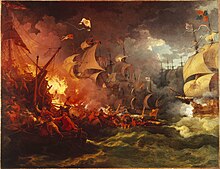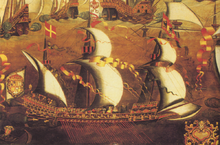Hugo of Moncada i Gralla

Hugo of Montcada i Gralla was the commander of the Galleasses of the Spanish Armada. He was the second son of Francesc I de Montcada, first Marquess of Aitona and Count of Osona, and his wife, Lucrècia Gralla.[1]
Belonging to the noble House of Montcada, his brother Gastó of Montcada i Gralla (first-born of 17 children) inherited the immense family fortune. His other brother was Joan of Montcada i Gralla, Archbishop of Tarragona (1613-1622) and Bishop of Barcelona (1610-1612).
Participation in the Spanish Armada
Charge
Hugo of Montcada was appointed commander of the fleet of Naples. The flagship was the Galleass San Lorenzo. The Galleass-galleon La Girona was part of that fleet. The Galleasses were:
- The San Lorenzo (captain-ship of the fleet of Naples)-Captain Joan Setantí.[2]
- The Zúñiga (patron-ship of the fleet of Naples)-Captain Pere Centelles
- La Girona-Captain Fabrizio Spínola, Genoese.[3]
- La Napolitana[4]-Captain Perrucchio Morán
Galleass San Lorenzo

This ship had 124 sailors, 50 guns, 300 oarsmen and 270 soldiers.[5][6][7]
It was built in Naples.[8] It displaced 762 tones and was the largest ship and, according to some, the most splendid of the entire Spanish Armada.
Nautical difficulties
One of the most difficult variables that made navigating the British Channel so dangerous were (and still are) the currents caused by the tides. Local pilots had good knowledge of those currents.[9]
Battle actions
- According to various testimonials (documentaries and film documentaries), the Galleass San Lorenzo could not progress rowing against the current caused by the tide.
- Alonso, Duke of Medina Sidonia did not give Hugo of Montcada permission to attack the Ark Royal when she was within his reach and in conditions of superiority.[10]
- The San Lorenzo was the first ship that warned of the danger of the eight ships sent by Francis Drake against the anchored Spanish navy.
- The order of the Duke of Medina Sidonia to cut the chains of the anchors of all the ships of the armada caused chaos and many collisions between them.
Final disaster
The references to the fact are numerous and not always coincident.[11][12][13][14][15][16][17][18][19][20]
In the confusion brought about by the collisions, a shock rendered unusable the rudder of the San Lorenzo. The maneuver with the oars was not sufficiently agile to fight under the attack of the enemies (from the Ark Royal in particular). Hugo of Montcada decided to go to refuge in the port of Calais (under French control and, in theory, neutral). He did not reach the entrance by sailing or the oars. The galleass tried to enter the port of Calais but bogged down near the entrance and lay half sideways. The soldiers (probably terrified by the incident) deserted the ship, jumping into the water. Many of them drowned. Only a few faithful remained aboard.
The English sent a few boats with soldiers to seize the galleass. Finally Charles Howard sent reinforcements with the Ark Royal's Panescalm boat to reduce the last resistance. Hugo of Montcada was killed with an arquebus shot to his head, and Joan Setantí and other Catalans defenders died as well.
Important testimonial
According to the work "Armada Invencible" by Cesáreo Fernández Duro, there is a description of the final attack and the death of Hugo of Montcada according to the statements of a slave of the Marquis de Santa Cruz (Volume I, page 118, document K.1467, item 18).[21]
See also
- Spanish Armada in Ireland
- List of Ships of the Spanish Armada
References
- ^ Fundación medinaceli
- ^ Cayetano Rosell (1863). Historiadores de sucesos particulares. M. Rivadeneyra. pp. 8–.
- ISBN 978-84-9967-849-8.
- ISBN 978-84-9969-965-3.
- ISBN 978-84-9967-849-8.
- ISBN 978-84-460-3983-9.
- ISBN 978-84-8472-127-7.
- ^ Luis Cabrera de Córdoba (1877). Filipe Segundo, rey de España ... [Por] Luis Cabrera de Córdoba ... Impr., estereotipica y galvanoplastia de Aribau. pp. 299–.
- ^ Video: Corrents de marea al canal de la Mànega.
- ^ Jacques-Auguste de Thou; Nicolas Rigault (1734). Histoire universelle de Jacques-Auguste de Thou: depuis 1543. jusqu'en 1607. pp. 181–.
- ^ Reign of Elizabeth ; Volume VI. 1870. pp. 477–.
- ^ Jacques-Auguste de Thou; Nicolas Rigault (1734). Histoire universelle de Jacques-Auguste de Thou: depuis 1543. jusqu'en 1607. pp. 186–.
- ^ Juan de Ferreras (1775). Synopsis histórica chronologica de España. en la Imprenta de Don Antonio Pérez de Soto. pp. 336–.
- ^ John Lothrop Motley (1860). History of the United Netherlands from the death of William the silent to the Synod of Dort, with a full view of the English-Dutch struggle against Spain, and of the origin and destruction of the Spanish armada. John Murray. pp. 493–.
- ISBN 978-1-350-01699-6.
- ^ The Field of Mars: Being an Alphabetical Digestion of the Principal Naval and Military Engagements, in Europe, Asia, Africa, and America, Particularly of Great Britain and Her Allies, from the Ninth Century to the Present Period ... Selected from the Best Historians and Journalists, and Adjusted from the Greatest Authority ... To which is Prefixed an Essay on the Art of War, and a Comprehensive System of Military and Naval Discipline ... J. Macgowan. 1801. pp. 72–.
- ^ The Christian Observer. Whiting & Watson. 1803. pp. 476–.
- ^ Andre Du Chesne (1666). Histoire d'Angleterre, d'Escosse, et d'Irlande, contenant les choses les plus dignes de memoire ... Nouv. ed., rev. et corr. et cont. ... par Du Verdier. Lovys Billaine. pp. 2–.
- ^ The Athenæum: A Journal of Literature, Science, the Fine Arts, Music, and the Drama. British Periodicals Limited. 1860. pp. 823–.
- ^ Carlos Coloma (1627). Las Guerras de los Estados Baxos desde el ano de mil y quinientos ochenta y ocho, hasta el de mil y quinientosnouenta y nueue. Recopiladas por do. Carlos Coloma cauallero del habito de Santiago . a costa de Miguel Manescal mercader de libros. pp. 7–.
- ^ Armada Invencible. Duro. Vol. 1.
External links
- The Story of the Tobermory Spanish Galleon
- The Defeat of the Spanish Armada. Insight into the context, personalities, planning and consequences. Wes Ulm
- English translation of Francisco de Cuellar's account of his service in the Armada and on the run in Ireland
- Elizabeth I and the Spanish Armada – a learning resource and teachers notes from the British Library
- The story of the Armada battles with pictures from the House of Lords tapestries
- BBC-ZDF etc. TV coproduction Natural History of Europe
- Discovery Civilization Battlefield Detectives – What Sank The Armada?
